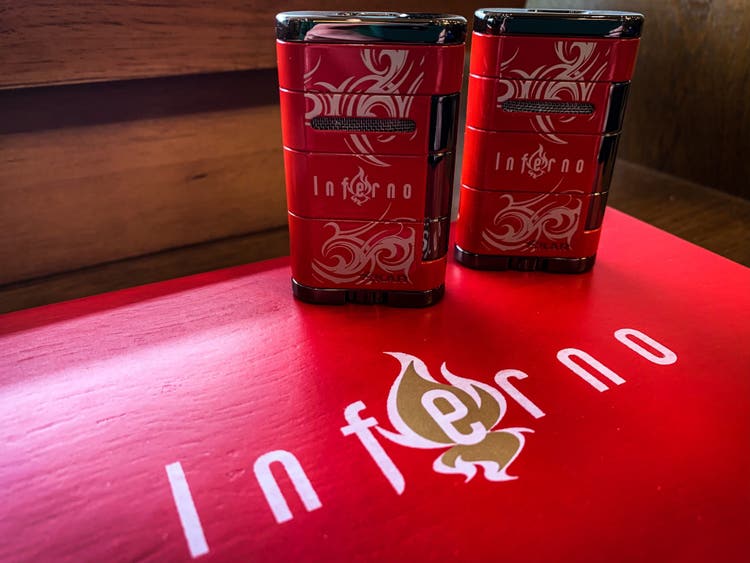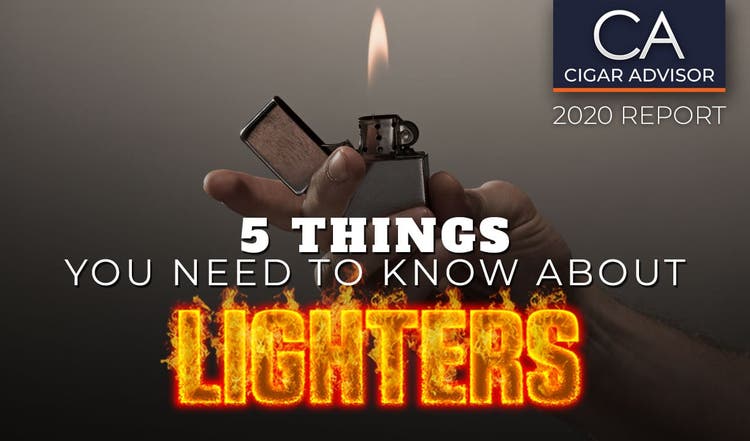
5 Things You Need To Know About… Cigar Lighters
Believe it or not, lighters came along less than 20 years after the advent of the match. There were earlier attempts made from converted flintlock pistols, but it was German chemist, Johann Wolfgang Döbereiner who prototyped the earliest standalone lighter in 1825. He named his device the Feuerzeug (often nicknamed, Döbereiner’s Lamp). It used chemical reactions to create hydrogen for the flame. A portable bomb of sorts – but popular in its day. Within three years, Döbereiner had sold more than 20,000 of ‘em.
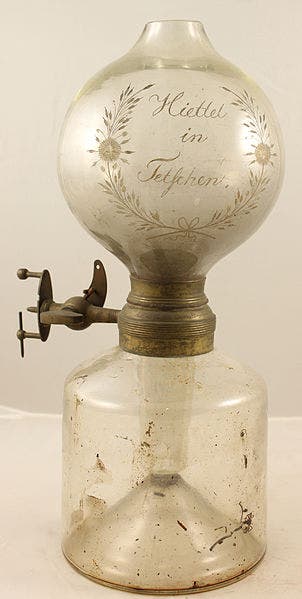
Lighters have become much more pocket friendly over the years, but the process of how they work is largely unchanged. Get a fuel source, contain it, and add some engineering and science to find a reliable means of igniting it.
The thing is, as simple and elegant in design as most of today’s lighters are, there are vast differences between them…both in what they’re designed to do and their price tags. And then there’s the learning curve aspect, too. We might not be walking around with highly volatile explosives inside a giant lamp anymore, but there’s still confusion out there on how to care for a modern lighter properly. And it’s a lot easier to do than you might think.
In this ‘5 Things You Need To Know…’ guide, we’re going to walk you through finding a good lighter at any price point, using the right fuel, maintenance tips, and more. Let’s get started.
Expensive Doesn’t Always Mean Better

We’ve all had it beaten into our brains from an early age. “You get what you pay for.” But sometimes, too good to be true, isn’t. And if you look around just about anywhere, you’ll find it in every industry. Cars, food, clothes, CIGARS…there’s plenty of good out there that doesn’t break the bank.
Take the Vertigo Cyclone, for example. $7 (at press time) gets you a triple torch jet lighter that will last you many years. And if you lose it, you won’t care, because what’s $7?
If a $7 lighter works perfectly, why do some sell for hundreds or more? The answer: brand names and eye candy. It’s the same reason you spend $15 for a graphic tee at Wal-Mart, and $500 on one from Gucci.
Top performing lighters are found in every price bracket, so all you need to ask yourself is, “do I want something that looks good, performs well, or both?”
My advice: only pony up the Benjamins when aesthetics are just as important as function. There are plenty of high-roller lighters that will burn a hole in your pocket, but their flames are the same as any other.

Not All Butane Is Created Equal
Cigar lighters come in three primary types:
1. Piezo-Spark Butane (Typical Torch and Soft Flame Cigar Lighters)
2. Zippo-style Wick
3. Disposable Sparkwheel (Bics, gas station lighters, etc.)
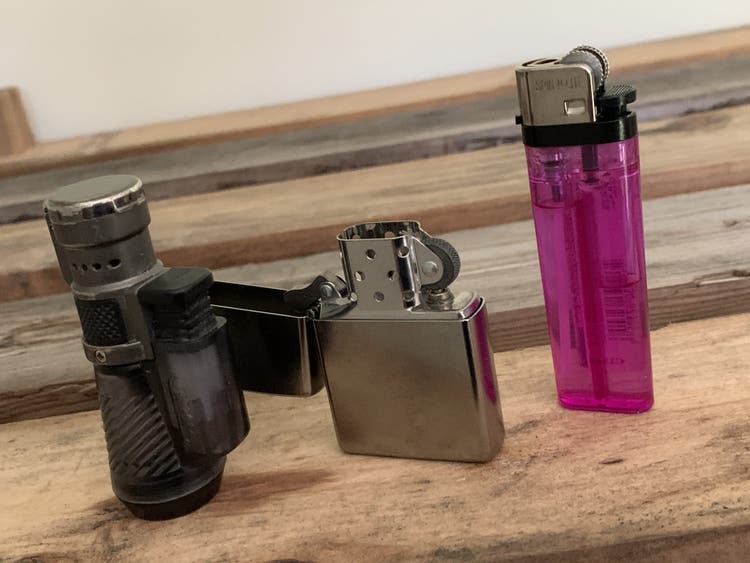
We can immediately toss #3 off the list. You’re not going to refill a disposable lighter.
Zippos and their knock-off brethren use a combination of Sparkwheels, flints, packing cotton, felt, and a wick. You basically pour the fluid into the cotton and it absorbs, soaking the wick in the process. When it comes time to refill your lighter, you’ve got many choices. You could put virtually any combustible fluid in there, but I’d only recommend using Zippo’s brand, or something like Ronson that’s made for those style lighters.
Pro Tip: Pop a Thunderbird insert into your favorite Zippo case and turn it into a modern-day torch lighter without ruining it. Wanna go back to the old way? Simply take it out and put the old Zippo insert back in and change anytime. No assembly, no fuss!
Take that same fluid and put it in a modern-day butane lighter, and you’re in for some real trouble – up to and including certain death of your torch. Some say it’s because Ronson and Zippo fluids are “dirty” but that’s not quite true. They’re just filtered less. Those impurities found in Ronson and Zippo fluid would clog the narrow fuel lines of modern lighters, and over time, block it off all together. Zippos don’t have fuel lines, so they don’t require processed butane.
When it comes to today’s piezo-style lighters (piezo is basically a spark generated from striking a small quartz crystal), there’re lots of butane options out there, some more questionable than others. Famous only carries reputable brands from companies like Xikar, Lotus, and Vector. Each has a formula that undergoes multiple distillations and won’t block up those fuel lines we talked about.

You’ve Got To Bleed and Fuel Your Lighter The Right Way
Bleeding and fueling your lighter are like takeoff and landing in an airliner: it’s where things are most likely to go wrong. Years ago, before I was a cigar junkie, I bought a jet torch lighter from a gas station. It worked like a champ for a few days and eventually ran out of gas. I picked up some butane and filled it – or so I thought. It worked for one or two lights and then it went dead again. I repeated the process and got the same results. I chucked it in the trashcan, muttering “what a piece of shit” under my breath. But the truth is, it was all my fault. I never bled the lighter. I wish I could go back and grab that thing from the garbage, armed with what I know now. I wonder how long it would have lasted.
Every time you light up, your torch burns a little butane. That butane is replaced by compressed air as it burns, and that means when your lighter is empty, it really isn’t. You’ve gotta get that air out.
If you don’t have a bleeder tool, you can get this Xikar multi-tool, or you can use something from around the house like an eyeglass screwdriver or even an unfolded paper clip or toothpick…anything thin and sturdy enough to keep constant pressure. Place your tool into the valve opening (usually on the bottom) and completely evacuate the fuel tank. It’ll sound like air coming out of a tire, and it’s usually cold, especially if there’s still some butane left. I like to shake the lighter a little as I do it, because I find it gets a little more out. Continue this until you stop hearing the hiss, and you know you’re done.
First, turn your lighter upside down. Place the butane can’s nozzle into the valve and press down with some force. This will ensure you have a good seal, which keeps butane from leaking out everywhere. Hold it down for a few seconds, or until you see that it’s full in the fuel window.
And then – this part is important – bleed it again. Not all the way, but just a short hit from your bleeding tool. But why, you ask? When we fill lighters, the seal isn’t perfect. Air can still make its way inside, and this way you’ll ensure most of it’s been removed from the lighter’s fuel tank. If you have a clear view fuel tank, you’ll see that it will fill up all the way after doing so, and that means you’ll get more lights before you need to fill it again.
Former CEO of Xikar, Kurt Van Keppel made a thorough tutorial on how to accomplish both bleeding and fueling, so check that out if you prefer a visual guide.

Soft Flame Lighters Are Better Than You Think
There’s no steeper learning curve for cigar smokers than patience. It’s a pastime that shouldn’t be rushed. And that’s what gives soft flame lighters an incredible advantage. They burn cooler, slower, and generally give a more even toast and light to your cigar.
Truth be told, you don’t have to spend a lot on one. You could literally buy a Bic for a couple of bucks at the store and it’ll last you a few weeks. If you’ve ever been to Cuba, Nicaragua, or any other cigar-bearing nation, you’ll see that’s all the old master blenders use. Smokers at the very least should be starting with soft flames. There’s less risk of damaging the cigar’s wrapper, and they’re less fuel-hungry. And it really doesn’t take much to turn a beautiful cigar wrapper into a charred, gross mess.
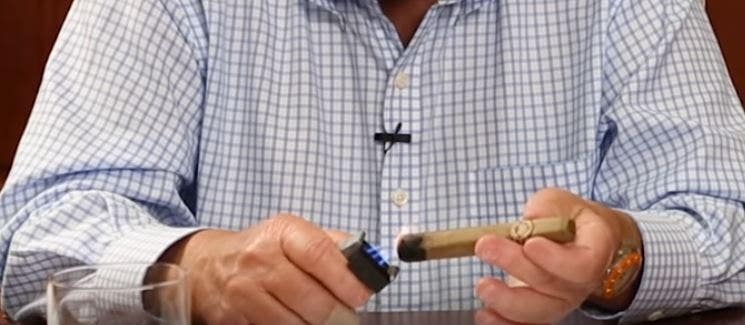
Pro Tip: Get yourself a reasonably priced soft flame pipe lighter. I know, I know. It’s meant for a pipe, but that bit of extension will help with ergonomics, and moves your hand out of the way so you can see just how close the flame is to the cigar. Because remember…whether you’re using a soft flame or a torch, you never want the flame to touch the cigar directly.
I like this Vertigo Governor because the flame comes out of the side, but it doesn’t have so drastic a footprint that it would feel awkward in your pocket. And that bonus tamping tool on the opposite side of the flame wheel adjustment – you can use that to bleed the lighter when it’s empty.

You’ll Need More Than One Lighter In Your Arsenal
I challenge all but the most occasional smokers to fire up everything they smoke with a single lighter. Sure, it can be done, but some lighters work better for different-sized cigars.
Let’s say you bought a shiny new quad-flame torch. That’s going to make quick work of your big-ring smokes. But when it comes time to light a corona – or a cigarillo – it’s like using a .50cal to take out a mouse. It’ll light it all right, but will there be anything left? Me, I’d just rather pull out something smaller like a single torch.
This lesson cuts both ways. Imagine trying to light a 70-ring with a single torch. It’s gonna take a while, and it’s gonna get hot. Too hot for your pocket right away.
And then there’s the convenience issue. Made it all the way out to the lounge and forgot your lighter? Not if you keep a spare inside your travel humidor. I try to keep one near the kitchen door to my deck, one in my car (except in the summer), and a Bic always in my pocket. I rotate what is where based on what I plan to smoke. I also like to take two with me when I go out, because if one runs out of butane, I have a backup without having to find a store.
